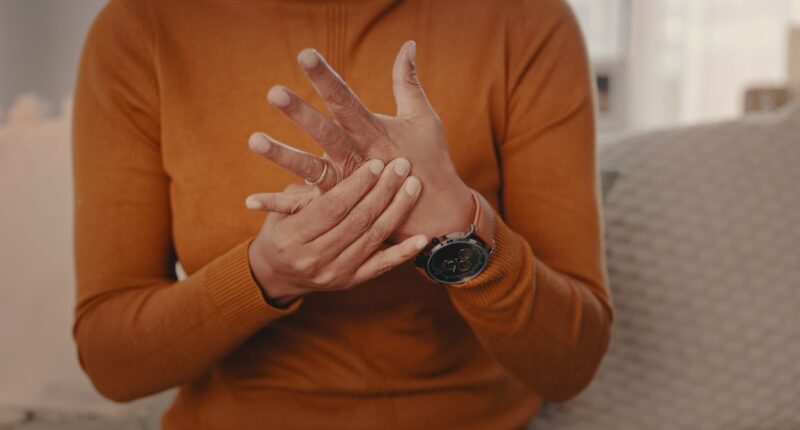Many of us encounter anxiety regularly, and it is crucial for our health to discover effective ways to deal with it. Despite the various methods available to alleviate stress, sometimes the most basic techniques can have the greatest impact.
One such practice is Vyakapa Nyasam, an Ayurvedic hand-cleansing self-massage technique designed to ground and calm you during moments of anxiety. Whether you’re starting your day, winding down before bed, or need a midday reset, this practice can become a valuable addition to your self-care routine.
How Ayurvedic massage helps with anxiety
Ayurveda, the ancient Indian system of medicine, emphasizes balance between mind, body, and spirit. During a personal wellness retreat at Sensei Porcupine Creek, I met mindset guide Per Erez, a senior yoga and meditation teacher with over 30 years of experience. He introduced me to simple ways to integrate practical tools from both yoga and Ayurveda to support my well-being.
“Traditional practices can help regulate the nervous system by either calming the mind and body—activating the parasympathetic response—or energizing and focusing our experience by engaging the sympathetic response,” says Erez. One of the most effective techniques in this realm is self-touch. Practices like Abhyanga, or self-massage, activate the parasympathetic nervous system, promoting relaxation and a state of calm.
Additionally, mudras (hand postures) can focus your mind, improve mental clarity, and help balance your nervous system. “The hands occupy a large portion of the brain’s sensory and motor cortices, so slow, deliberate movements with conscious attention can activate these brain regions, promoting a sense of calm focus,” Erez explains.
Sirichand Khalsa, MD, a physician and Ayurvedic specialist, adds that making self-massage an intentional process offers an opportunity for grounding and mindfulness, which can introduce balance into our busy and hectic lives. She emphasizes that Ayurveda is remarkably intentional, bringing a quality of stress reduction and resiliency through circadian rhythm modulation.
What is Vyakapa Nyasam?
Vyakapa Nyasam, also known as the “cleansing arms” flow, is a simple yet powerful yoga practice for stress relief. While not widely offered in classes, it has been introduced in one-on-one sessions by experts like Erez at Sensei, showcasing its effectiveness in integrating meditation and yoga for anxiety management.
This flow involves nine repetitions of slow, mindful movements paired with deep breathing. The sequence uses self-touch to provide sensory feedback, helping to clear the mind and improve body awareness.
“It’s a simple practice that offers profound benefits.” —Per Erez, yoga and meditation teacher
How to practice Vyakapa Nyasam
Set aside 5 to 10 minutes in a quiet space where you won’t be disturbed. Begin by standing or sitting comfortably, ensuring your spine is straight, and take a few deep breaths to center yourself.
- Bring your palms together at your heart, pressing lightly to feel the connection.
- Slide your right hand down the inner side of your left forearm, moving slowly and mindfully.
- Slide your left hand up the outer side of your right forearm, continuing the deliberate pace.
- Slide your left hand back down the inner side of your right forearm.
- Slide your right hand up the outer side of your left forearm.
- Return both palms together at your heart, taking a deep breath.
- Repeat this sequence 9 times, synchronizing your movements with your breath.
Focus on the sensation of your hands moving along your arms, and allow any distracting thoughts to pass without attachment.
The benefits of Vyakapa Nyasam
“Vyakapa Nyasam can help clear the mind, regulate stress, and improve body awareness,” says Erez. “It’s a simple practice that offers profound benefits.”
- Mind clearing: The repetitive, mindful movements help clear mental clutter, making space for calm and clarity.
- Stress regulation: By activating the parasympathetic nervous system, this practice reduces stress hormones and promotes relaxation.
- Enhanced body awareness: The tactile sensation of self-touch increases your connection to your body, grounding you in the present moment.
Tips for incorporating Vyakapa Nyasam into your routine
“Self-massage can be thought of as part of ‘dinacharya,’ or the daily routine, rather than just a quick task,” Dr. Khalsa says. “Making it an intentional process offers an opportunity for grounding and mindfulness.”
- Morning calm: Start your day with Vyakapa Nyasam to set a peaceful tone and prepare your mind for what’s ahead.
- Midday reset: If you find yourself overwhelmed during the day, a quick session can help you refocus and reduce anxiety.
- Evening wind-down: Practice before bedtime to release the day’s tension and promote restful sleep.
Enhance the experience by incorporating additional Ayurvedic techniques, as Dr. Khalsa notes: “Breathing awareness and mindful touch can make the experience even more grounding.”
- Breathing awareness: Begin with a few deep breaths to center your attention.
- Mindful touch: Emphasize specific motions like keeping your fingers touching each other or rotating wrists to stimulate different energy points.
- Herbal essential oils: Consider adding essential oils like lavender, sandalwood, or lemon to your practice, each with Ayurvedic balancing properties.
The bottom line
Consistency is key. Making Vyakapa Nyasam a regular part of your routine can amplify its benefits over time. “It’s ideal for a calming morning routine or to wind down before bed,” says Erez. “The practice can be done in a quiet space for 5 to 10 minutes.”
My experience engaging in this grounding practice at Sensei not only introduced me to this transformative practice, but also highlighted the importance of intentional self-care in our hectic lives. Incorporating Vyakapa Nyasam into your daily routine can provide a simple yet profound way to navigate anxiety and cultivate inner peace.





